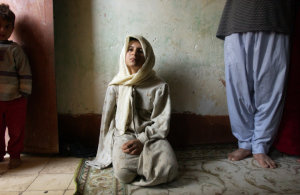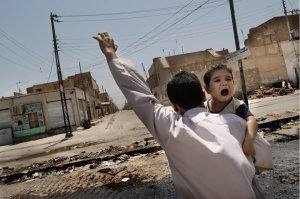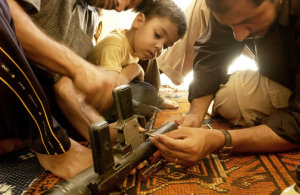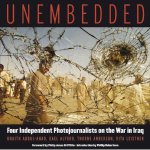Photo Corners headlinesarchivemikepasini.com
![]()
A S C R A P B O O K O F S O L U T I O N S F O R T H E P H O T O G R A P H E R
![]()
Reviews of photography products that enhance the enjoyment of taking pictures. Published frequently but irregularly.
Photographs From The Unembedded


11 February 2013
Downtown. Late in the afternoon, after the pages we'd made up had gone to press. We escaped the office for a haircut. Friday the 13th. 1998.
The barber we had found over 20 years ago wasn't busy that late in the day. He'd turn on the old black and white TV to watch cartoons.
Not this time, though. He had the Lehrer News Hour on, the East Coast broadcast, which airs at 3 p.m. here.
He was upset about the U.S. threat to bomb Iraq, which in fact would occur in December. As he put it, it's the people of Iraq who would suffer. "It's always the people who suffer," he said softly.

Photo by Thorne Anderson
He wasn't Iraqi himself. He always referred to himself as Persian. He gone to work as a child to help support his family, sweeping up a barber shop. When his broom was idle, he studied the barbers. And learned to cut hair. Though he couldn't read and write, he had opened his own shop in San Francisco after working at the Original Palace Barber Shop for many years.
We thought of him last Friday when we visited the de Young Museum.
We'd gone to see Johannes Vermeer's Girl with a Pearl Earring, painted in 1665 and restored in the 1990s. It's a stunning work, its subtlies not easily respected in our over-saturated world (her lips are almost always shown too red; in person they are quite natural). An odd subject, actually, when you think portraits of wealthy patrons were how you paid the rent, not portraits of girls who couldn't pay you.
But whenever we go to the de Young, we sneak into the one room reserved for photography. It's always worth a peek.
This time we caught a preview of Eye Level in Iraq: Photographs by Kael Alford and Thorne Anderson. And remembered our barber's lament.
Alford and Anderson, who are married to each other, captured these images during a two-year span just before the 2003 invasion. Working outside the U.S. military's embedded journalist program, they were able to document the Iraqi militias that challenged the Allied forces and later the new Iraqi government. They focused on how the war affected ordinary people.
Alford put it this way:
I consider these photographs invitations to the viewer to learn more, to explore the relationships between public policy objectives and their real world execution and to consider the legacies of human grief, anger, mistrust and dismay that surely follow violent conflict. I hope that these images will also open a window on the grace of Iraq and perhaps help to give a few of these memories a place to rest.
You can see many of the 62 exhibit images online. Probably the simplest approach is to Google "Alford Anderson Unembedded" and click on the Image search.

Photo by Kael Alford
What you'll see there is much of what we saw at the de Young, minus the intriguing artifacts in the two display cases. Those included a compact satellite phone, a bill for lens repair, the military's regulations for embedded journalists, Iraqi paraphernalia decorated with Hussein's image and more.
But it's the photos that will stay with you. And not just the ones that capture the anger of young men in the dusty streets, some wielding heavy arms, some simply raising their fists. Or the corpse of a child in a tiled room you are surprised to learn was the hospital.
There is, for example, what for all the world seems to be, at first glance, a family portrait in front of a nice home, three sons standing behind their seated father, all of them holding what look like musical instruments. But look closer and you'll see they are holding weapons as they stand guard on their wealthy street to deter looters.

Photo by Thorne Anderson
Or the bizarre river of fire in the street at night, a row of young men tending it. What kind of tailgating is that? No kind. They are melting asphalt over buried bombs in the road. Not the kind of shot you get when you're embedded with the target of those bombs.
Or the face of the child studying the gun being assembled by the men of the house over their hand-woven rug. A choice, ten years ago, between the world of culture woven in the rug and the world represented by the weapon. What became of that child, you find yourself wondering. What choice did he make?
There was a series of images of bones being unearthed from Shiite massacre site at Hilla after Hussein had been deposed. Anderson's shot of a plain wooden coffin with some of those bones being returned to a village and met on the road by one woman with her fists to her chin and another with her arms outstretched told the story. But between them a child too young to have known the victim held her arms outstretched as well, the suffering inherited.

Photo by Kael Alford
There are shots from Kabul and from Faluja and from Sadr City but there is also a series of images of burqa-dressed women at a bridal shop, the bride outside wearing one of the Western gowns but with her head covered.
The shot of an old tea room, sparsely inhabited by men drinking tea and smoking water pipes, was strangely moving. But it wasn't the spare figures that struck us. We were drawn instead to the worn wooden benches and the tiny tables scattered around the cafe, which more closely resembled a Greyhound bus station than a Starbucks.
Still it's the faces that we can't erase from our mind's eye. They are angry, they are contorted in pain, they are sad, they are terrified, they are weary. Some defiant, some defeated.
They are, as our barber had long ago predicted, suffering.
Notes
Prints. While the colors are vivid and credible, detail is of another era -- but sufficient for the newspapers that first published these images. It's easy to forget the photos were taken in 2003 when the 6.3-Mp Canon 10D and Rebel 300D and were the wonders of the day, along with the 4.1-Mp Nikon D2H. They were all printed on inkjet printers but no other details were revealed.
Lecture. The San Francisco Art Institute will host a lecture by the pair Friday, Feb. 15 at 7:30 p.m. Tickets, available at the door, are $10.
Catalog. The exhibition is accompanied by a book, Unembedded: Four Independent Photojournalists on the War in Iraq (2005), published by Chelsea Green Publishing. The volume contains the photographic collaboration of Anderson and Alford plus the work of Ghaith Abdul-Ahad and Rita Leistner, two other independent photojournalists.
Images. Images are reproduced courtesy of the de Young Museum and the High Museum of Art, Atlanta. Lead shot on the Headline page is by Thorne Anderson.
Eye Level in Iraq: Photographs by Kael Alford and Thorne Anderson
At the de Young Museum from Feb. 9 to June 16
SAN FRANCISCO -- Eye Level in Iraq: Photographs by Kael Alford and Thorne Anderson presents the photographs of two American-trained photojournalists, Kael Alford (American, b.1971) and Thorne Anderson (American, b. 1966), who documented the profound impact and aftermath of the U.S.-led coalition's invasion of Iraq in 2003. Alford and Anderson created this body of work during a two-year span that began in the months leading up to the invasion and continued into the period when armed militias emerged to challenge the coalition forces and later the new central Iraqi government. This exhibition will be on view in Gallery 12 at the de Young Museum in San Francisco from Feb. 9--June 16.
In an attempt to get closer to the daily realities of Iraqi citizens, the photographers worked outside the confines of the U.S. military's embedded journalist program. Though this shift in physical perspective placed them in great danger, they sought to learn how the war and the seismic political and cultural shifts that accompanied it were affecting ordinary people. Civilians, so often caught in the crossfire of conflict, are the primary subject in the extraordinary photographs of Alford and Anderson. They are approached not from a fixed military perspective, but from a more intimate point of view, one closer to "eye level."
Baghdad fell to the allied forces on April 9, 2003. A decade later, reflecting on why this work was made, Alford has stated: "I consider these photographs invitations to the viewer to learn more, to explore the relationships between public policy objectives and their real-world execution and to consider the legacies of human grief, anger, mistrust and dismay that surely follow violent conflict. I hope that these images will also open a window on the grace of Iraq and perhaps help to give a few of these memories a place to rest."
Exhibition
This exhibition is organized by the Fine Arts Museums of San Francisco and draws upon 62 digital inkjet prints generously loaned by the High Museum of Art, Atlanta.
Exhibition CatalogueThis exhibition is accompanied by a book, Unembedded: Four Independent Photojournalists on the War in Iraq (2005), published by Chelsea Green Publishing. The volume contains the photographic collaboration of Thorne Anderson and Kael Alford and the work of two other independent photojournalists, Ghaith Abdul-Ahad and Rita Leistner. Combining text and images in an unflinching perspective, Unembedded illustrates the simultaneous brutality and poignancy of war-torn Iraq.
